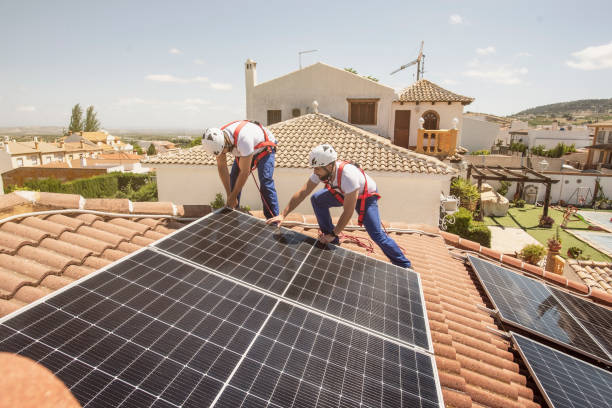A solar panel uses clean renewable energy from the sun to generate electricity for your home. The solar panel system consists of several different components, including a series of individual photovoltaic cells.

The cells are made from a nonmetal semiconductor called silicon (atomic number 14 on the periodic table). When sunlight interacts with a photovoltaic cell, it causes electrons to move around inside it, initiating a flow of electricity.
Solar Cells
When the Sun’s rays hit a solar cell, photons, which are particles of light, are absorbed by the semiconductor material. These photons knock electrons loose, which then drift through the cell to form an electric current.
As with all semiconductor materials, the strength of this current determines how much energy a solar cell can produce. That’s why solar cells have to be highly efficient, converting sunlight to electricity as efficiently as possible.
Fortunately, there are a few ways to improve the efficiency of your solar panel. One approach is to add an anti-reflection coating, which blocks the Sun’s rays from reflecting off the surface of your solar cell.
Another approach is to apply a textured surface to the front of your solar cell, which will trap more light rays. These textured surfaces, such as nanoscale inverted pyramids or amorphous silicon, can increase the absorption of light by up to 30 times.
A third approach is to add a layer of small light-emitting clumps of material, called quantum dots, to your solar cell. Quantum dots can absorb lower-energy red and infrared light from the Sun, increasing how much electricity your solar cell can produce.
Photovoltaic Modules
Photovoltaic (PV) modules are a vital component of any solar power system. They are composed of a group of fotovoltaika Príbram cells wired together in series and parallel to produce the voltage and current that a particular system requires.
PV cells are a semiconductor material that absorbs and converts sunlight, which is made up of small bundles of light called photons, into electricity. The photons knock electrons from the cell’s atoms, causing them to flow together in a current.
The amount of electricity that the cells generate depends on their size, efficiency and exposure to the sun’s radiation. These factors influence how many cells you need for your system.
PV modules can be grouped into arrays of different sizes to produce small to large amounts of electricity. Modules are typically positioned so that they are facing the sun at an angle that maximizes power generation.
Power Conversion
Solar panels transform the energy from the sun’s rays into usable electricity. This electricity then goes to your home’s electrical panel and is distributed throughout your house.

There are two main ways to convert solar energy into electricity: photovoltaic (PV) and concentrated solar power (CSP). CSP is a more expensive option, but it uses mirrors to concentrate sunlight onto receivers that collect heat.
PV cells, on the other hand, use conductive material to conduct electricity. The cells can be made from purified silicon, or a mix of phosphorus and boron to balance out the positive and negative charges.
In order for the electricity generated by a solar panel to be useful, it must be converted from direct current (DC) to alternating current (AC). This conversion is done by an inverter.
Storage
A solar panel converts the sun’s energy into electricity that you can use to power your home. If you want to store that excess energy for later, you need a battery system.
Batteries can be used to store solar electricity for use at night, or on cloudy days when your panels aren’t generating enough to charge your batteries. They’re also useful for taking advantage of time-of-use rate plans, where electricity costs less during off-peak times (like overnight), as well as for providing backup power in the event of a grid outage.
Summary:
Storage can reduce demand for dirty, inefficient peaker plants that are located in high-demand areas like cities, reducing air pollution and public health impacts. Storage can also smooth out demand, avoiding price spikes for electricity customers, and provide community resiliency.
